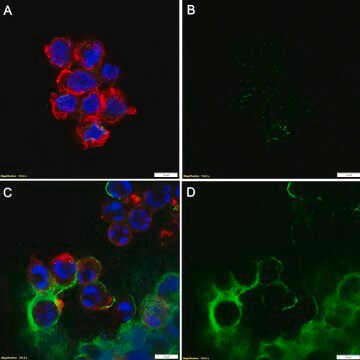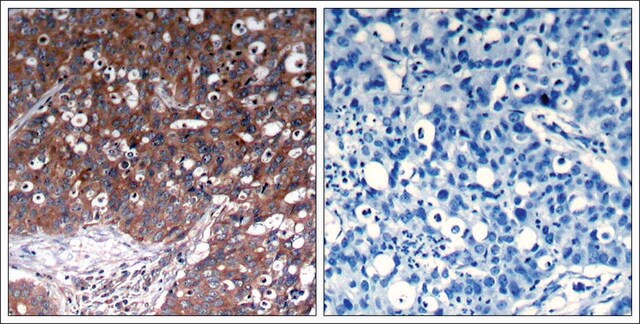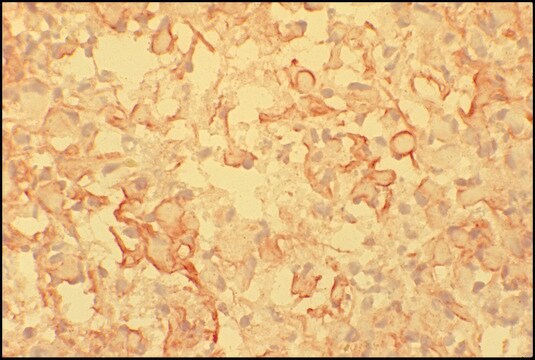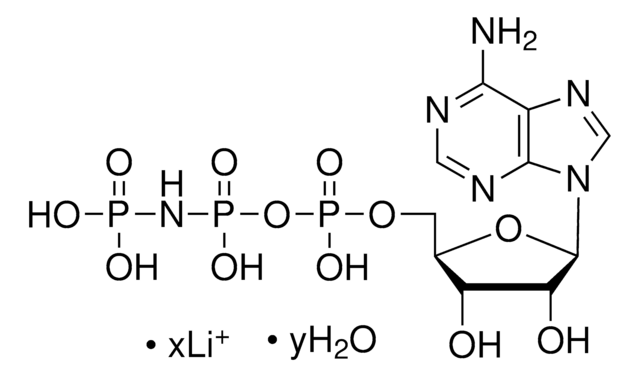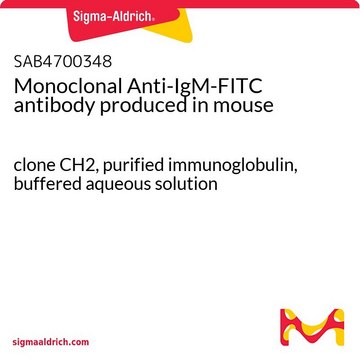16-256
Anti-Phosphatidylserine Antibody, clone 1H6, Alexa Fluor™ 488
clone 1H6, Upstate®, from mouse
Sign Into View Organizational & Contract Pricing
All Photos(2)
About This Item
UNSPSC Code:
12352203
eCl@ss:
32160702
NACRES:
NA.41
Recommended Products
biological source
mouse
Quality Level
conjugate
ALEXA FLUOR™ 488
antibody form
purified immunoglobulin
antibody product type
primary antibodies
clone
1H6, monoclonal
species reactivity
vertebrates
manufacturer/tradename
Upstate®
technique(s)
flow cytometry: suitable
isotype
IgG
shipped in
wet ice
target post-translational modification
phosphorylation (pSer)
Related Categories
General description
Significance:
Anti-Phosphatidylserine may be used to detect translocation of the membrane phospholipid phosphatidylserine (PS) from the inner to the outer cell membrane leaflet; it provides an alternative to Annexin V for quantitation of apoptosis.
Anti-Phosphatidylserine may be used to detect translocation of the membrane phospholipid phosphatidylserine (PS) from the inner to the outer cell membrane leaflet; it provides an alternative to Annexin V for quantitation of apoptosis.
Phosphatidylserine, or PS, is a naturally occurring, phospholipid nutrient. PS is essential to the functioning of all the cells of the body, but is most concentrated in the brain. Its relative abundance in this organ reflects its proven involvement in an assortment of nerve cell functions, including nerve transmitter release and synaptic activity. Clinical studies have suggested that PS can support brain functions that tend to decline with age.
Specificity
Recognizes phosphatidylserine (PS) in cell membranes.
Immunogen
Liposomes containing 70% phosphatidylserine and 30% phosphatidylglycerol.
Application
Detect Phosphatidylserine using this Anti-Phosphatidylserine Antibody, clone 1H6, Alexa Fluor 488 validated for use in FC.
Research Category
Apoptosis & Cancer
Apoptosis & Cancer
Research Sub Category
Apoptosis - Additional
Apoptosis - Additional
Quality
Flow Cytometry: 0.2 μg of this antibody detected Phosphatidylserine in fixed Jurkat cells (see page 2).
Apoptosis Assay: Time course for induction of apoptosis in Jurkat cells by staurosporine, measured using either an Anti-Phosphatidylserine, clone 1H6, Alexa Fluor™ 488 conjugate or an Annexin V FITC conjugate.
Apoptosis Assay: Time course for induction of apoptosis in Jurkat cells by staurosporine, measured using either an Anti-Phosphatidylserine, clone 1H6, Alexa Fluor™ 488 conjugate or an Annexin V FITC conjugate.
Physical form
Protein G Purified
Purified mouse monoclonal IgG in buffer containing PBS containing 1% BSA, 0.05% Tween, 0.05% sodium azide. Liquid at 4ºC.
Storage and Stability
Stable for 1 year at from date of receipt.
Analysis Note
Control
Negative Control: Catalog # 16-240, Normal Mouse IgG, Alexa Fluor™ 488-conjugate.
Negative Control: Catalog # 16-240, Normal Mouse IgG, Alexa Fluor™ 488-conjugate.
Other Notes
Concentration: Please refer to the Certificate of Analysis for the lot-specific concentration.
Legal Information
ALEXA FLUOR is a trademark of Life Technologies
UPSTATE is a registered trademark of Merck KGaA, Darmstadt, Germany
Disclaimer
Alexa Fluor™ is a registered trademark of Molecular Probes, Inc.
Unless otherwise stated in our catalog or other company documentation accompanying the product(s), our products are intended for research use only and are not to be used for any other purpose, which includes but is not limited to, unauthorized commercial uses, in vitro diagnostic uses, ex vivo or in vivo therapeutic uses or any type of consumption or application to humans or animals.
Unless otherwise stated in our catalog or other company documentation accompanying the product(s), our products are intended for research use only and are not to be used for any other purpose, which includes but is not limited to, unauthorized commercial uses, in vitro diagnostic uses, ex vivo or in vivo therapeutic uses or any type of consumption or application to humans or animals.
Not finding the right product?
Try our Product Selector Tool.
Storage Class Code
12 - Non Combustible Liquids
WGK
WGK 2
Flash Point(F)
Not applicable
Flash Point(C)
Not applicable
Certificates of Analysis (COA)
Search for Certificates of Analysis (COA) by entering the products Lot/Batch Number. Lot and Batch Numbers can be found on a product’s label following the words ‘Lot’ or ‘Batch’.
Already Own This Product?
Find documentation for the products that you have recently purchased in the Document Library.
Yuta Nakazawa et al.
eLife, 10 (2021-11-10)
Although tumor-infiltrating regulatory T (Treg) cells play a pivotal role in tumor immunity, how Treg cell activation are regulated in tumor microenvironments remains unclear. Here, we found that mice deficient in the inhibitory immunoreceptor CD300a on their dendritic cells (DCs)
Yi An et al.
Scientific reports, 11(1), 6392-6392 (2021-03-20)
Head and neck squamous cell carcinomas (HNSCC) induced by human papillomavirus (HPV) have increased recently in the US. However, the distinct alterations of molecules involved in the death pathways and drug effects targeting inhibitor of apoptosis proteins (IAPs) have not
Lazar Mandinov et al.
Proceedings of the National Academy of Sciences of the United States of America, 100(11), 6700-6705 (2003-05-20)
The induction of an acute inflammatory response followed by the release of polypeptide cytokines and growth factors from peripheral blood monocytes has been implicated in mediating the response to vascular injury. Because the Cu2+-binding proteins IL-1alpha and fibroblast growth factor
P Nusbaum et al.
Biochemical Society transactions, 32(Pt3), 477-479 (2004-05-26)
CD43 down-regulation during the apoptosis of PMN (polymorphonuclear cells) is not caused by proteolysis or internalization. Could it be released with bleb-derived membrane vesicles? Membrane blebbing was followed by microscopy on PMN 'synchronized' by an overnight incubation at 15 degrees
Mark C Weir et al.
PloS one, 12(7), e0181178-e0181178 (2017-07-21)
Acute myelogenous leukemia (AML) is often associated with activating mutations in the receptor tyrosine kinase, Flt3, including internal tandem duplications (ITDs) within the regulatory juxtamembrane region. Previous studies have linked Flt3-ITD to the activation of the Fes protein tyrosine kinase
Our team of scientists has experience in all areas of research including Life Science, Material Science, Chemical Synthesis, Chromatography, Analytical and many others.
Contact Technical Service